Table of contents
A guide to integrating with HiBob’s API
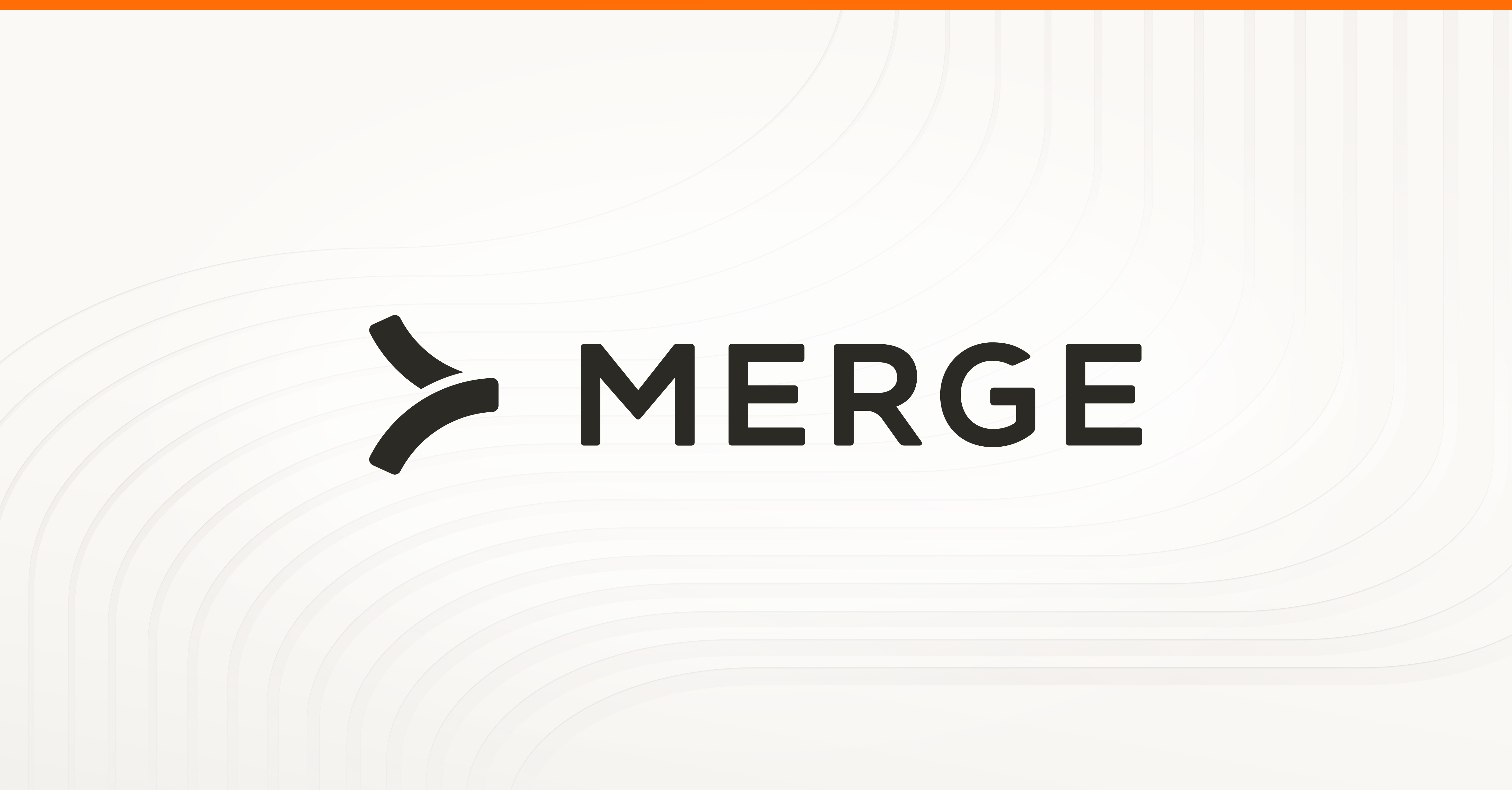
HiBob offers a leading HRIS platform that streamlines the entire employee lifecycle—from onboarding through off-boarding. It also empowers employees and managers with everyday tools for 1:1s, time-off requests, and performance management.
Given all of the different types of data and processes collected and run in HiBob, you can benefit from integrating the HRIS with your internal applications and/or your product in a variety of ways.
To that end, we’ll break down some impactful ways to integrate with HiBob. We’ll also walk through the steps for setting up an API-based HiBob integration and share best practices for implementing the integration—regardless of your use case.
But first, let’s align on some of the basics.
Overview on the Hibob API
The Hibob API, otherwise known as “Bob API”, is a collection of REST-based endpoints that let you access data and functionality in the HRIS application.
You can integrate HiBob’s endpoints with your internal applications to streamline employee and/or candidate workflows; or you can connect your customers’ instances of HiBob with your product to enhance your product’s functionality.

The endpoints you’d want to use depend on your use case, but here are a few of the most common ones:
- People API: This lets you perform nearly any activity on employee data in Hibob, such as adding a new employee, revoking an employee’s access, and updating an employee’s email address
- Time off API: You can use this API to submit, modify, or cancel a time off request, review your PTO balance, see who’s currently on PTO, and more
- Tasks API: Leverage this API to review tasks (e.g., provisioning applications for a new hire) holistically or an individual level and to update them at scale or on an individual basis
- Workforce planning API: This API helps you retrieve, modify, and create positions, whether that’s assigning a budget to certain open positions, viewing all positions at your company, reviewing the positions that are currently open, and more
Like any API provider, HiBob also assigns specific rate limits across its endpoints, offers pagination support, and enforces permissions.
Related: A guide to using the Paylocity API
API rate limits
In the case of rate limits, HiBob typically assigns a rate limit that’s anywhere from 10 to 100 requests per minute. For example, here’s how the rate limits look across the People API’s endpoints:
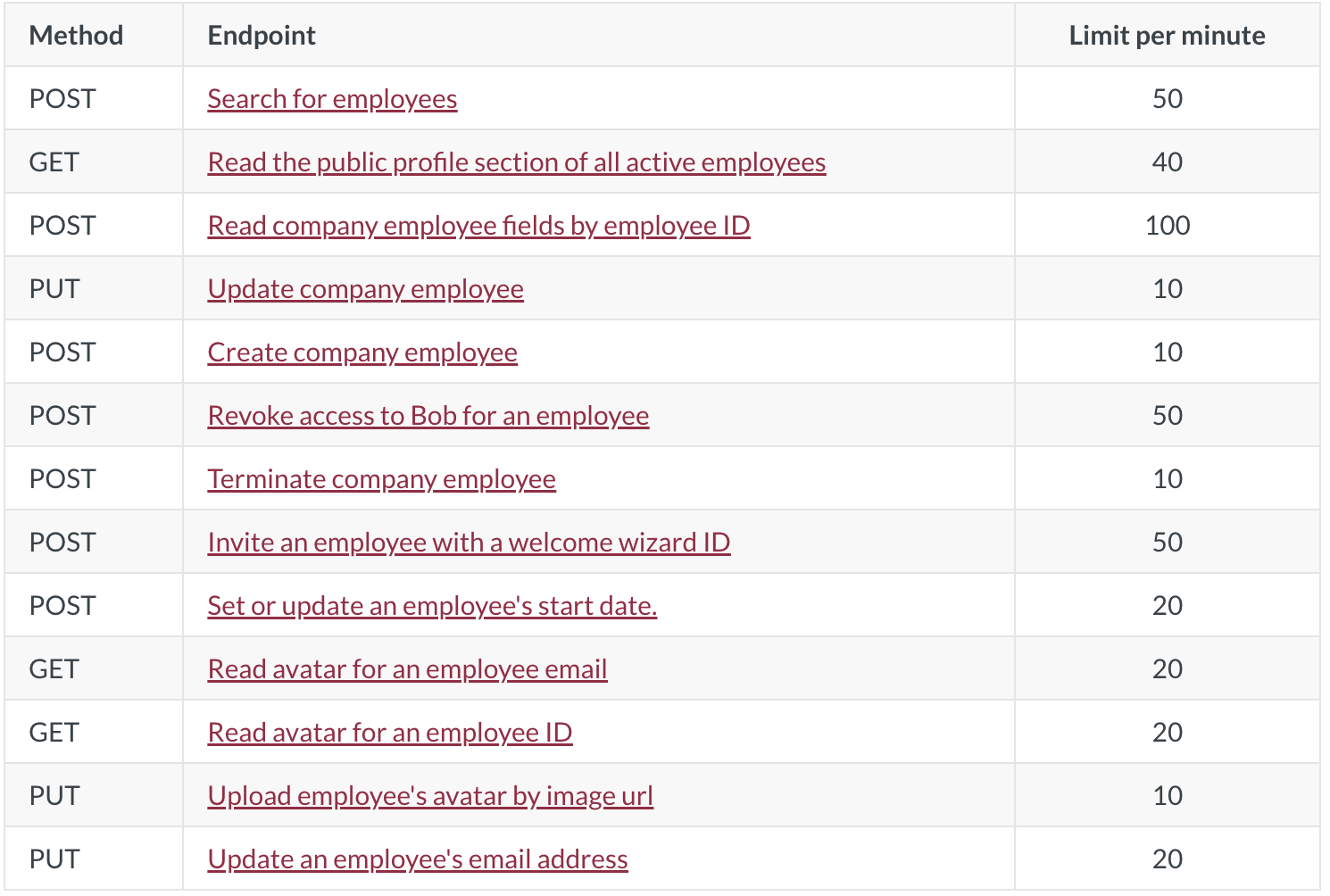
API pagination
HiBob uses cursor pagination for certain endpoints (listed here). This approach involves using a cursor in a request to clarify the starting point for fetching data from a resource.
For other endpoints, the documentation doesn’t explicitly state the pagination method. However, it’s likely that these use a simpler approach—such as offset pagination, which relies on an offset parameter to determine how many records to skip.
API authentication
HiBob supports two authentication methods for API requests:
- Service user authentication: You can create a service user in HiBob, which provides an API key and secret. These credentials are used to authenticate requests and are the preferred, future-proof method
- Legacy basic auth key: This involves using a single API key tied to an admin user account. This approach still works but it’s considered legacy and may be deprecated in the future
For service user authentication, you’d need to create appropriate permission groups in HiBob and assign them to your service user (we'll show you how to do this in the next section); for basic auth keys, the admin user account needs the necessary permissions to access the data you're requesting.
Webhooks
Finally, HiBob offers webhooks to support real-time workflows.
You can register a webhook in HiBob to listen for specific events—like a new employee being created or a time-off request being submitted. When these events happen, HiBob sends a notification to your webhook URL, which can then trigger actions in your other internal applications or your product (this depends on your implementation).
Related: A guide to integrating with Workday
How to authenticate with HiBob’s API
Regardless of your integration use case(s) for HiBob, you’ll need to authenticate your API connection. And since HiBob requires end users to create an API service user to authenticate to their API, you’ll need an ID and a token for authorization.
Here’s how to generate your credentials and configure a permissions group.
Step 1: Create an API service user
From the homepage, navigate to System Settings. You can find it by clicking the icon next to the HiBob logo on the top left of your screen.
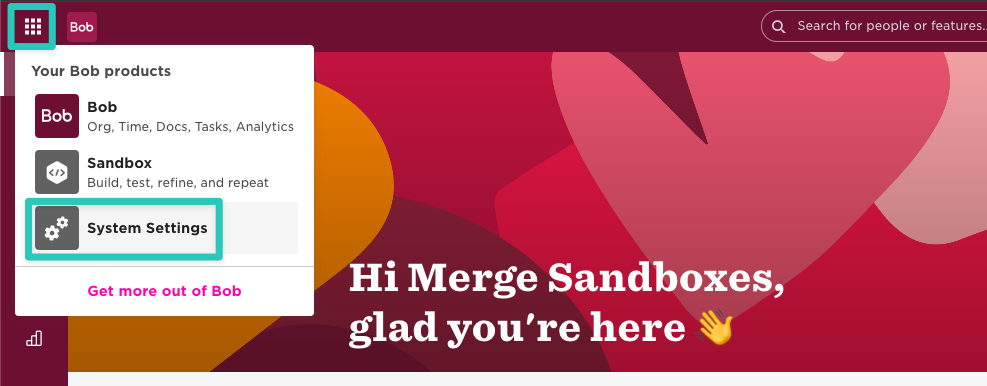
Open Integrations, and then select “Manage” under “Service users.”
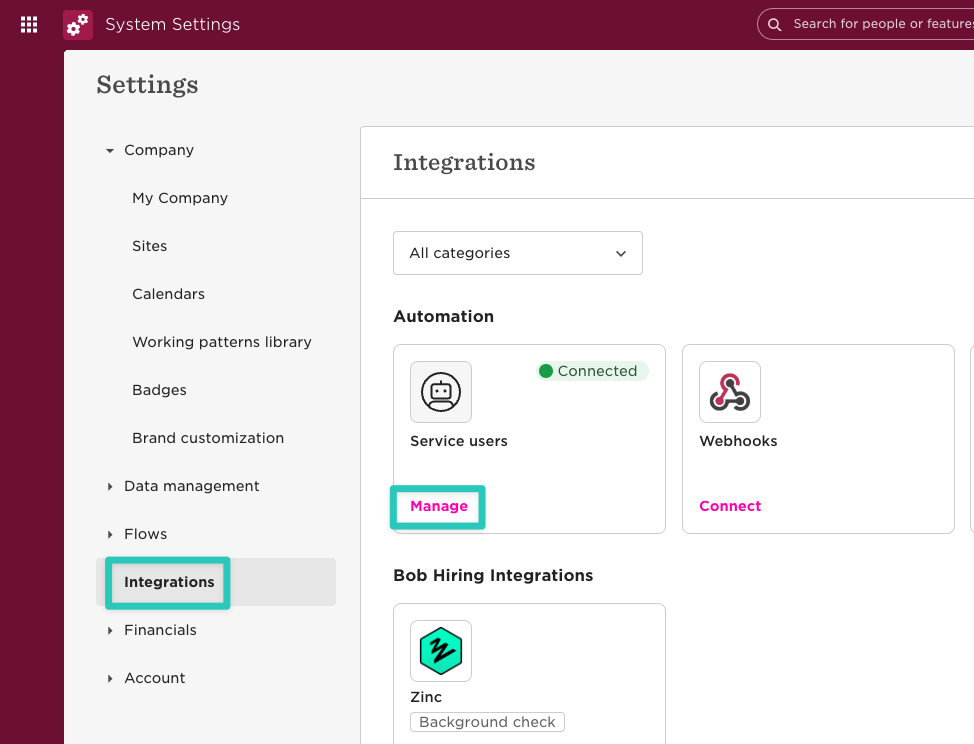
Click on the “Create service user” button.
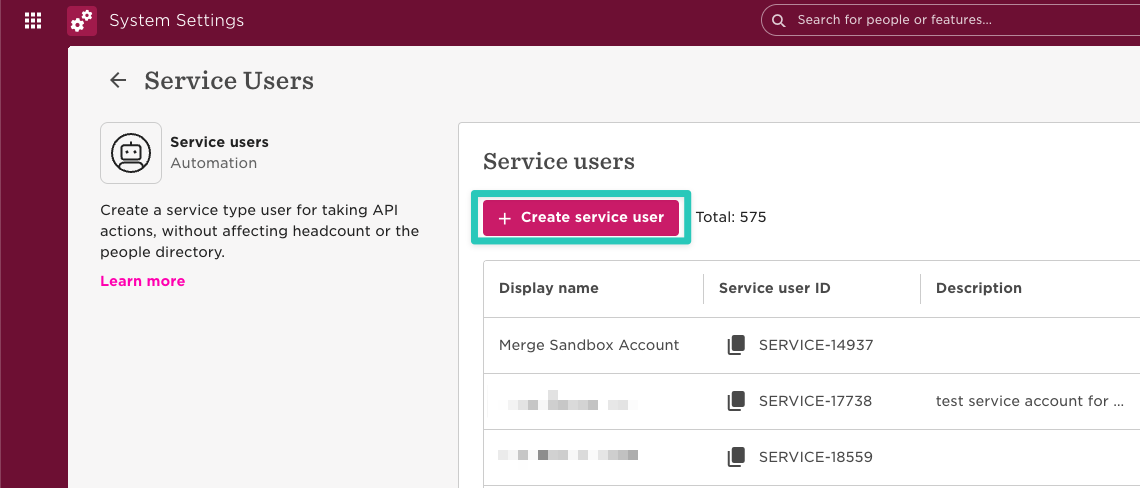
You should now see your unique ID and credentials for your service user account.
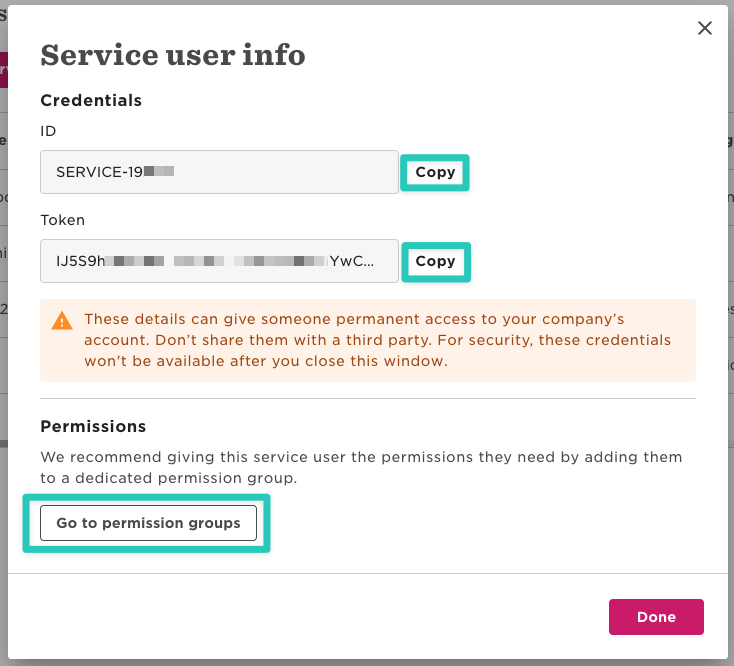
Related: A guide to authenticating with and using Paycor's API endpoints
Step 2: Create a permission group
Click on “permission groups” (see screenshot above), and then select “Service user.
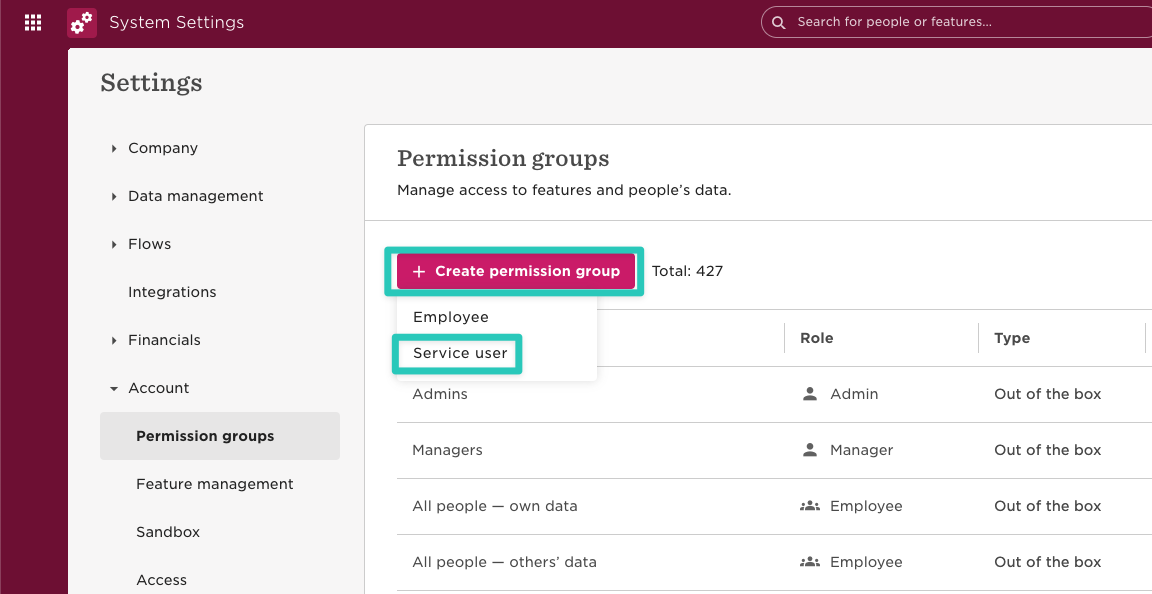
Enter any group name, and then select your new service user under “Select service users.” From there, click ”Create.”
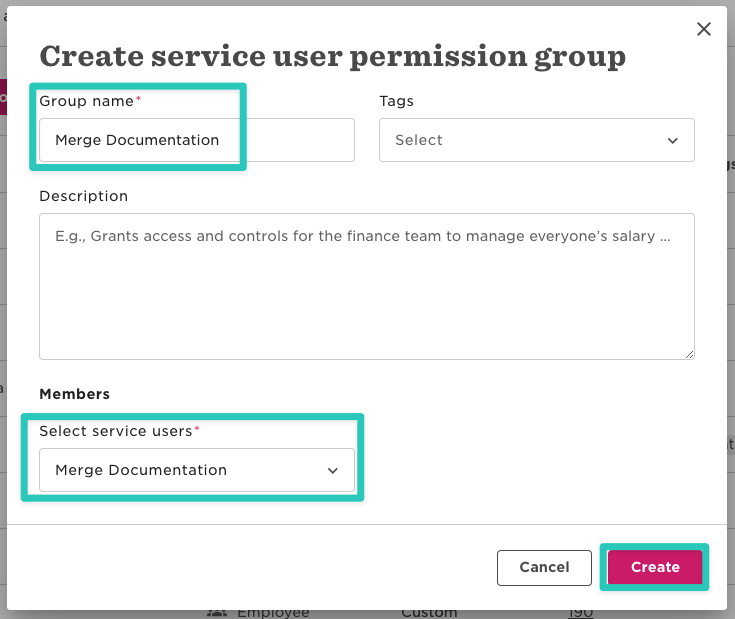
Step 3: Assign permissions
Under the People’s data tab, toggle on “Select people by condition" under “Whose data can members access?” Then click on “Edit” to select the people the integration can access.
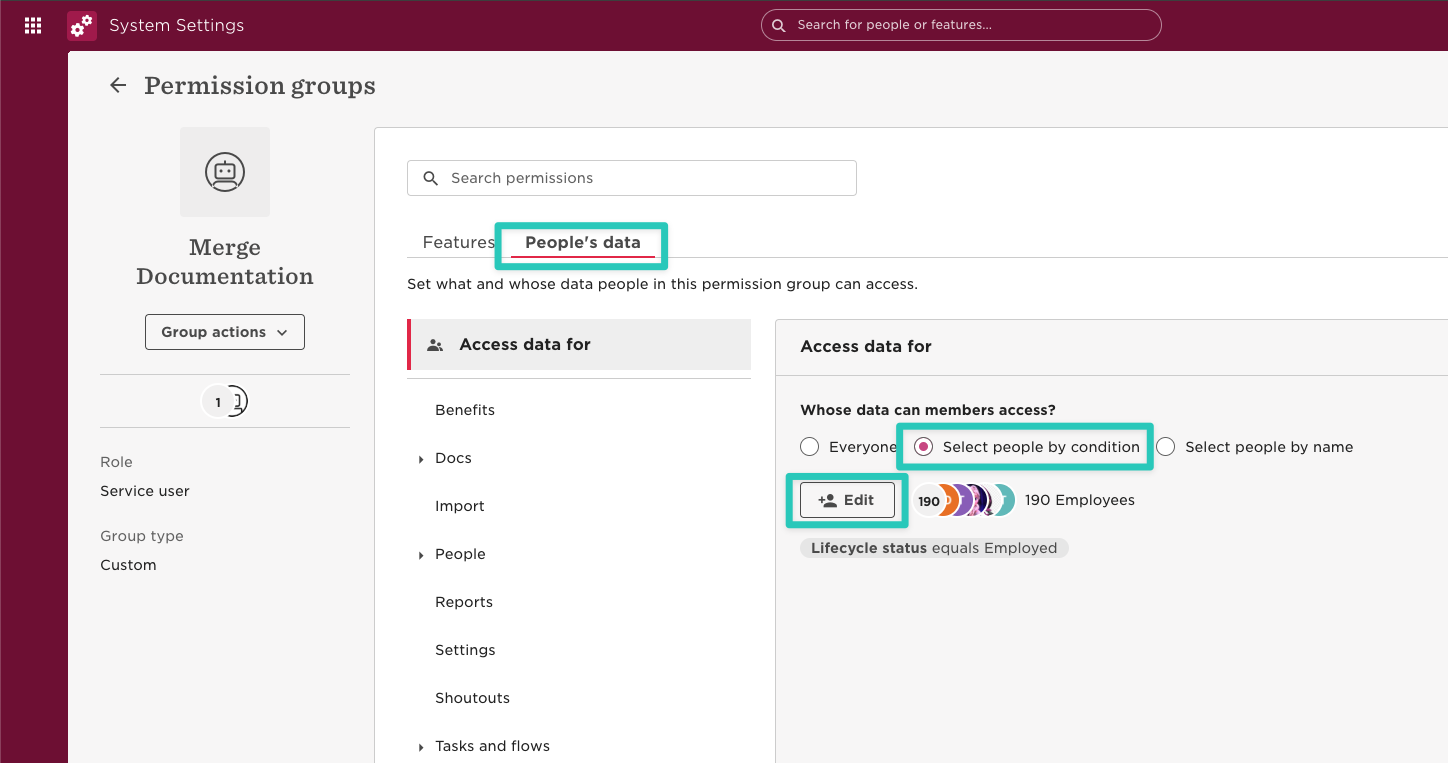
You should now see a “Select people by condition” pop-up. Click on all relevant lifecycle statuses. In most scenarios this will include Hired, Employed, and Terminated.

4. Add permissions
Go back to the “People's data” tab. Under “Access rights”, click on “People.”
You should now be able to configure the permissions specific to your use case(s).
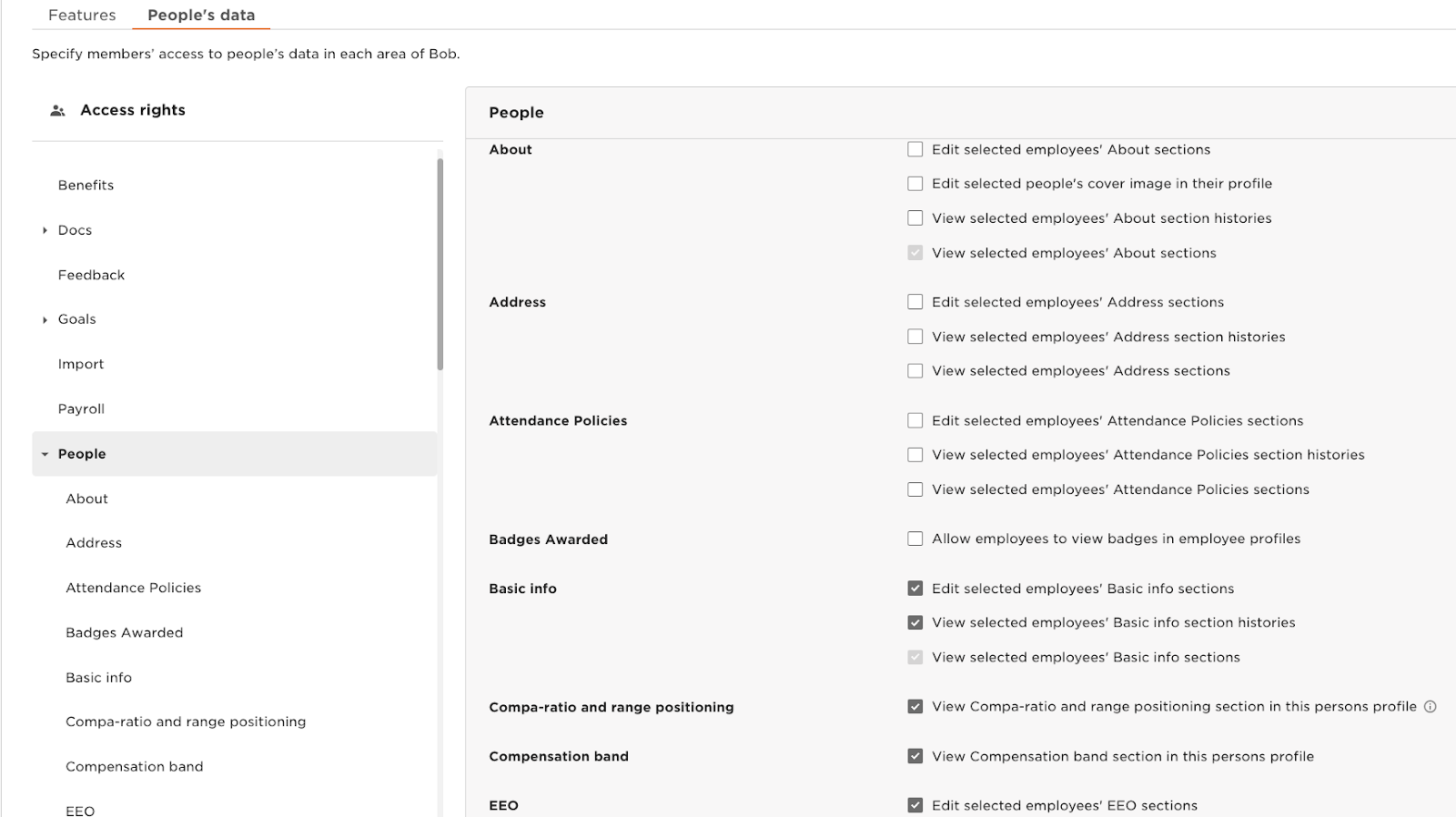
5. Save the permission group
Once you’ve finished adding permissions, you can finish creating the Permission Group by selecting “Save.”
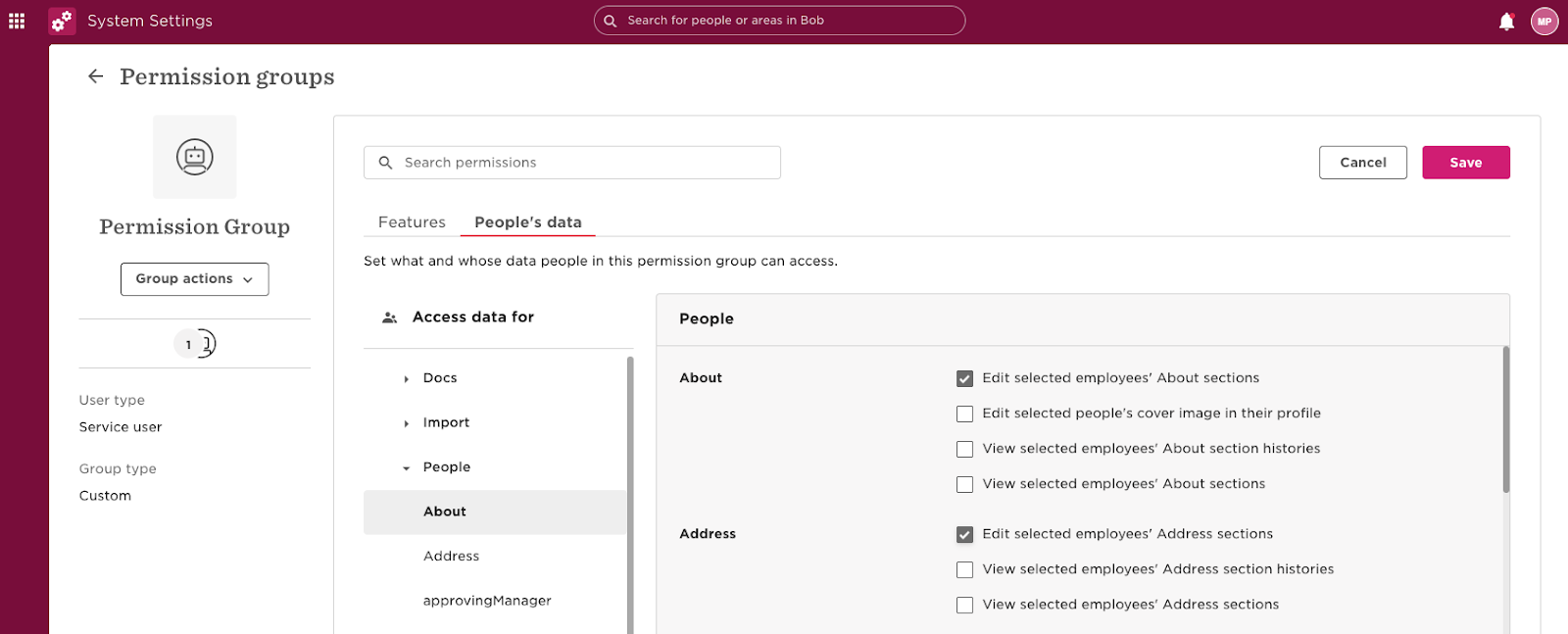
API integration examples for HiBob
To help you pinpoint the best integration use cases for HiBob, let’s walk through a few examples.
Internal integration examples for HiBob
Here are a few internal integrations you can build with HiBob.
Connect HiBob with your ATS to automate employee pre-boarding
To give your IT and HR teams enough time to pre-board incoming employees, you can integrate HiBob with your ATS (e.g., Greenhouse) and build a flow where once a candidate is marked as hired in your ATS, they’re automatically created in HiBob.
You can also sync a wide range of fields between the two systems, such as the new hires’ full names, start dates, job titles, departments, addresses, and more to give your team enough context to begin pre-boarding them effectively.

Integrate HiBob with your communications platform to announce employee milestones
To help you broadcast notable employee milestone events to the broader team, such as a promotion or a work anniversary, you can integrate HiBob with your communications platform (e.g., Slack) and build a flow where once a milestone event occurs, a message gets sent to a specific channel.
As part of building this integration, you can configure the information included in the message and the channel that receives it.

Hook HiBob up with a business intelligence platform to find actionable employee insights
To help your analysts understand the root causes of employee churn, engagement, and other key areas, you can connect HiBob with a business intelligence platform (e.g., Tableau) and consistently sync a wide range of employee data (like employees’ full names, employment statuses, and job titles).

Product integration examples for HiBob
Here are some impactful ways to connect your product with HiBob.
Automate user provisioning
To help your customers add users to—and remove them from—your product automatically, you can connect customers’ instances of HiBob with your product and build the following workflows: Any a time a user is added to HiBob, their profile gets created in your product, a; and any time a user is removed from your product, they’re deactivated in your product.
You can even unlock certain product functionality based on the data that’s piped in.
For example, say you offer a peer-to-peer recognition platform, like Bonusly. If you add an employee of a certain job level, they can get more points to award their peers. And, based on the department they’re in, they may be eligible to access certain recognition awards.
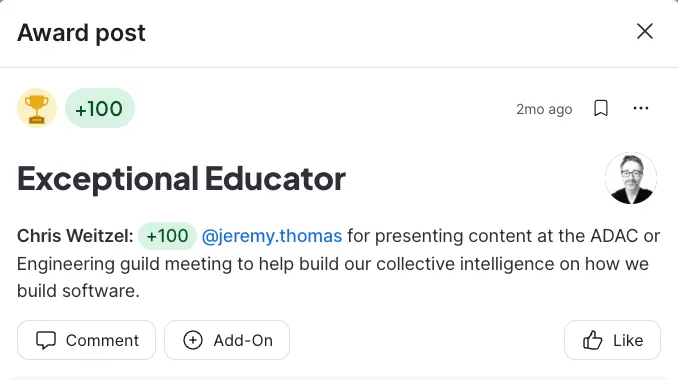
Monitor when employees come into the office
Say you offer a workplace management solution that helps customers’ employees coordinate when they come into an office.
To help you support this use case, you can integrate with customers’ HiBob instances and not only sync standard employee data, like full names, job titles, and departments, but also their approved time off and the days they’ll be working remotely.
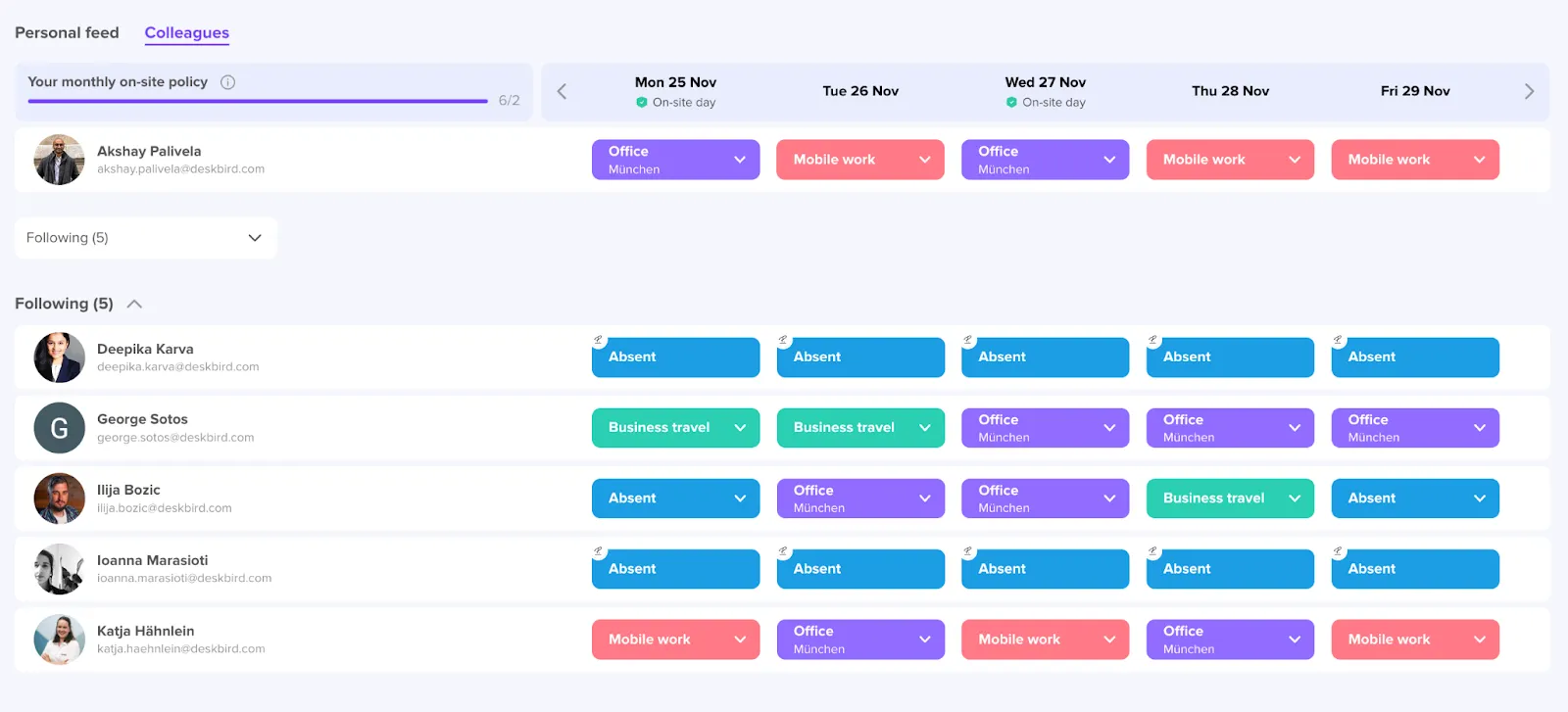
Power a wide range of AI agents for employees
Imagine you offer AI agents that can help your customers’ employees perform tasks faster.
In many cases, you’ll need your AI agents to integrate with customers’ instances of HiBob in order to complete tasks or gather relevant context. For example, if you want your AI agent to help users submit PTO requests, you can integrate it with HiBob's POST time off endpoint.

Best practices for integrating with HiBob
Before you begin the process of integrating with HiBob, here are some best practices to consider:
- Ensure end users create separate API service users for different use cases. Each use case likely requires different HiBob data permissions, so this helps enforce the principle of least priviledge
- Leverage lifecycle status data. HiBob includes future hires, terminated employees, contractors etc. Confirm that the service user can see all appropriate lifecycle status values so that your integration captures complete workforce data across the employee lifecycle
- Take advantage of HiBob’s customizability. You can use custom fields in HiBob, like employee badges, skill levels, certification expiration dates, or project assignments to capture data specific to your—or your customers’—use case
- Use a unified API solution to build a customer-facing HiBob integration. If you’re looking to integrate HiBob with your product, you’re also likely looking to connect to other HRISs.
To that end, you can leverage a unified API platform, which offers a single API to access a whole category of integrations (like HRIS). This will help you add all of the HRIS integrations your prospects and customers need quickly and easily

Related: A guide to integrating with HRIS solutions
Integrate 70+ HRISs—including HiBob—with your product via Merge
Merge, the leading unified API solution, lets you connect HiBob and dozens of other HRISs with your product through its Unified HRIS API.

Merge also provides:
- Comprehensive Common Models (normalized data models) and advanced features to sync custom data, such as Field Mapping and Authenticated Passthrough Request
- Integration observability features—from fully-searchable logs to automated issue detection functionality—to help your customer-facing teams manage integration issues on their own
- Best-in-class support to help you not only resolve issues quickly but also get the guidance needed to take your integrations to market successfully
Learn more about how Merge can help you add and support customer-facing HRIS integrations at scale by scheduling a demo with one of our integration experts.




.png)

.jpg)

.png)
.png)
